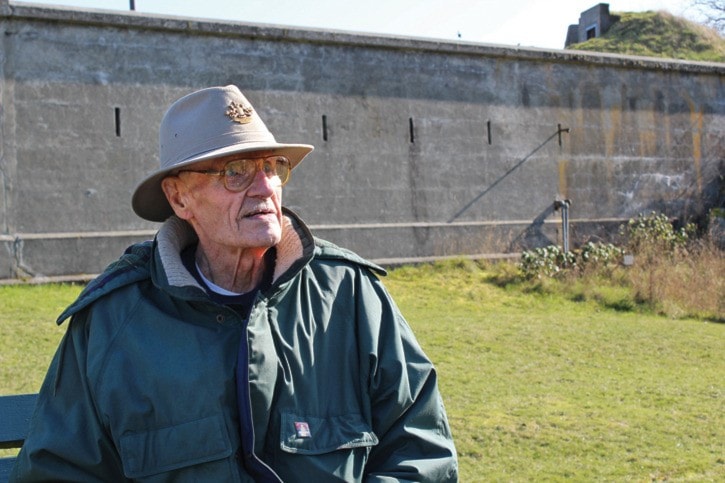Visitors from all over the world visit Fort Rodd Hill every year, but for one man, that walk through the gates is a trip back in time.
The sound of the guns, the smell of coffee brewing in the fort’s canteen and the view over the mouth of Esquimalt Harbour through young eyes come flooding back to Jack Stevens whenever he visits the fort.
At 94 years of age his visits are becoming less frequent, but with more than 85 years of history with the historic site, they are always an event. The Sidney resident came to the fort with his daughters on Monday to visit his favourite spots and share a few stories.
Stevens was about seven years old the first time he came to Fort Rodd Hill in 1925 with his father, Henry, who as a bombardier with the Royal Canadian Artillery, was dispatched to the fort during summers for training camps.
As a boy Stevens would spend part of his summers in camp with his family at the fort. His father helped operate the original six-inch artillery guns that were the centrepiece of the fort when it was constructed by the British in the late 19th century.
Stevens himself ended up serving at the fort during the Second World War, when he served as a battery sergeant major of the Royal Canadian Artillery’s 27th Light Antiaircraft Battery.
He joined in 1939 at the outbreak of the war and spent three years at Fort Rodd Hill helping protect the strategically important entrance of Esquimalt Harbour.
“There’s nothing like the army, there really isn’t. I can’t say enough about it,” Stevens said. “I love the army, it was great.”
Dave King, manager of the Fort Rodd Hill National Historic Site, said Stevens is one of the last living people to have heard those original guns fire, as they were decommissioned and ultimately melted down for the metal during the Second World War.
Although never fired in aggression, the British would once a year raise the red flag on the fort to warn boaters and then fire a shot without a round.
“There’s always that dwindling band of guys who were here from the prewar years and it just gets smaller and smaller every year,” King said.
“We’re losing the personal connection for sure. You can read in history books which battles were fought and what happened but you’re losing that personal touch, those stories that Jack tells.”
Visually the fort looks much the same as when Stevens first visited some 80 years ago.
A row of buildings that once lined the field at the centre of the fort are gone but otherwise the basic look of the site remains relatively unchanged.
Some 25 years ago staff recorded Steven’s recollections of his history with the fort. Those recordings are now used as a part of audio exhibits inside the battery for visitors.
For this visit he brought with him a photograph of his father and friend Frederick “Punch” Grimes on the beach in front of the fort in 1924, a memento that Stevens holds dear.
“It’s memories, you know?” Stevens said. “I spent a lot of time in the artillery and we moved around all over the place, over in Europe and all around, and there’s no place like a fort. It’s something about it, especially a place like this where I spent a lot of time. It’s very nice.”
The federal government has done the fort justice, Stevens says, through its preservation efforts and its honouring of the fort as a national historical site.
“Somebody had to take it over and look after the place and you can see what a fine job they’ve done,” Stevens said.
“I’m not exaggerating one little bit, they’ve kept the place up nicely.”
news@goldstreamgazette.com
